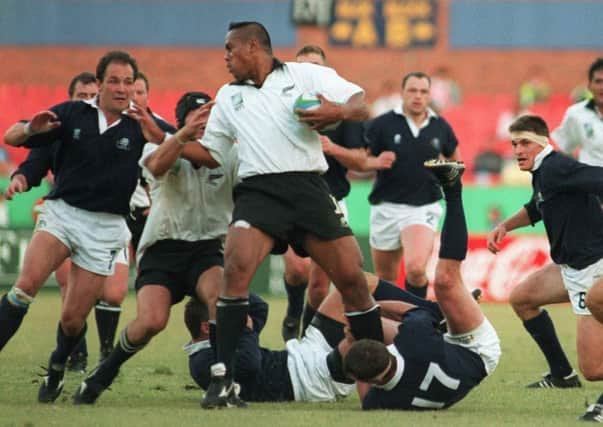Iain Morrison: Jonah Lomu - the first global superstar


He wasn’t the next big thing, he was the first big thing, the original, and still the best, global superstar of the newly professional age even if he first came to prominence in the amateur era. I still remember rumours of some teenage kid from New Zealand who switched between No 8 and wing and was pretty impressive at both. This sort of thing simply didn’t happen back then. You were a forward or you were a back. To see someone master both was almost literally incredible.
If it hadn’t been for Nelson Mandela, the big Kiwi would have owned the World Cup in 1995, but even he was unable to withstand the desperate need of a nation willing the Springboks on in that edgy final. The Boks had witnessed the havoc Lomu wrought against Ireland, Scotland and especially England. They double-teamed him. Joost van der Westhuizen, another player plagued by dreadful illness who Lomu recently visited, made a famous tackle on the big fella in full flight which summed up the South African’s bloody-minded refusal to bend a knee, even to a 20- year-old sporting phenomenon.
Advertisement
Hide AdAdvertisement
Hide AdThe home nations had not been so fortunate. Ireland had conceded two tries to the big man in the pool stages, although Wales had somehow kept a lid on him. Scotland restricted him to one score before he cut loose against England with four tries, most of which left a trail of white shirts lying in his wake, wondering what the hell had just hit them.
In the aftermath, England skipper Will Carling called him a “freak” which was a little lacking in grace but perhaps understandable. The point was not that Lomu was so big and quick, although he was, almost exactly the same size and speed as Glasgow’s new recruit Taqele Naiyaravoro, it was the fact that everyone else at the time was a normal size. The players had not yet bulked up for the professional era. Rugby players looked like slightly bigger versions of people on the street rather than the muscle-bound behemoths that now inhabit the field.
I played for Scotland in that 1995 game and I recall us asking the coaches if we had any special strategy to stop Lomu? No, the answer came back, because if we concentrated on him we’d only leave holes elsewhere. It was wishful thinking. Admittedly, Lomu scored only one try that afternoon at Loftus Versfeld, but he made a good mess of our defence almost every time he got the ball, with the little Bath prop David Hilton reduced to throwing himself at the big man’s ankles to act as a human speed bump, something that would earn him a yellow card these days. I never got near the big guy although, if I’m honest, I am not sure how hard I tried.
The man marking him, Craig “Jackie” Joiner, pictured left, was no slouch but still Lomu left him for dead at least twice, taking the long rout around the outside. It must have been almost a relief to see Lomu opt to go past you rather than over you.
“I guess it was a bit,” Joiner reminisces. “Don’t you remember there was some story that Gregor Townsend opted to give away a penalty by intentionally going offside at a scrum rather than have to tackle him!? It doesn’t sound likely, I know, but then again Gregor is a pretty smart person!
“It is a sad day but to be honest I never really knew him very well. When I think of Jonah I just see this big guy wandering around with a pair of massive headphones on, cutting himself off from the rest of the world.
“I think he found it difficult to come to terms with his fame when he was so young but as he grew older he seemed to be more at ease with it.”
At the end of the 1995 match, Joiner attempted to swap jerseys but instead returned to the Scotland dressing room with Lomu’s extraordinary shorts. Joiner had muscular thighs himself but still he was able to put two legs through one of the openings in these giant shorts.
Advertisement
Hide AdAdvertisement
Hide AdHe still has them in the attic somewhere although my suggestion that he might want to sell them is swatted aside. “They are worth more to me than anyone else.”
Can Joiner remember anything else about that 1995 quarter-final? “I think we played pretty well that day with the final score 45-30 in their favour. We probably did the best of the home nations, although it wasn’t good enough to beat the All Blacks.”
I played against Lomu once more after that. London Scottish sent a scratch social side to the Dubai Sevens. Scotland tighthead Paul Burnell made the squad, which may give you an indication of how seriously we were taking the sport.
It was the first scrum on the first match on the first day of the tournament and already the temperature was in the mid 30s. Luckily, I was able to take refuge in the shade of my rival prop who towered over everyone. It was Lomu, although he was unusually restrained on the day. While the Kiwis won, it wasn’t before we had dropped the ball over their line and allowed them to go the length for the winner.
After the 1995 World Cup, Jonah Lomu Rugby was launched on X-Box. I never played the game but those who did assured me that the eggheads who had programmed the game enabled me to run around Lomu.
It was, let’s be honest, the only place that was ever going to happen.